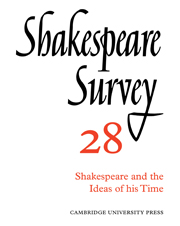Book contents
- Frontmatter
- ‘Richard II’ and the Realities of Power
- The Politics of Corruption in Shakespeare’s England
- Literature without Philosophy: ‘Antony and Cleopatra’
- Self-consciousness in Montaigne and Shakespeare
- ‘Measure for Measure’: The Bed-trick
- Shakespeare and the Doctrine of the Unity of Time
- ‘Coriolanus’ and the Body Politic
- ‘Titus Andronicus’, iii, i, 298–9
- ‘The Merchant of Venice’ and the Pattern of Romantic Comedy
- The Integrity of ‘Measure for Measure’
- ‘To Say One’: An Essay on ‘Hamlet’
- ‘The Tempest’ and King James’s ‘Daemonologie’
- Sight-lines in a Conjectural Reconstruction of an Elizabethan Playhouse
- The Smallest Season: The Royal Shakespeare Company at Stratford in 1974
- The Year's Contributions to Shakespearian Study 1 Critical Studies
- 2 Shakespeare’s Life, Times, and Stage
- 3 Textual Studies
- Index
- Plate section
The Integrity of ‘Measure for Measure’
Published online by Cambridge University Press: 28 March 2007
- Frontmatter
- ‘Richard II’ and the Realities of Power
- The Politics of Corruption in Shakespeare’s England
- Literature without Philosophy: ‘Antony and Cleopatra’
- Self-consciousness in Montaigne and Shakespeare
- ‘Measure for Measure’: The Bed-trick
- Shakespeare and the Doctrine of the Unity of Time
- ‘Coriolanus’ and the Body Politic
- ‘Titus Andronicus’, iii, i, 298–9
- ‘The Merchant of Venice’ and the Pattern of Romantic Comedy
- The Integrity of ‘Measure for Measure’
- ‘To Say One’: An Essay on ‘Hamlet’
- ‘The Tempest’ and King James’s ‘Daemonologie’
- Sight-lines in a Conjectural Reconstruction of an Elizabethan Playhouse
- The Smallest Season: The Royal Shakespeare Company at Stratford in 1974
- The Year's Contributions to Shakespearian Study 1 Critical Studies
- 2 Shakespeare’s Life, Times, and Stage
- 3 Textual Studies
- Index
- Plate section
Summary
Measure for Measure has an exceptionally vexing critical history. It has disturbed or antagonized critics from the time of Dr Johnson, and almost every aspect of it is a subject of controversy in modern criticism. It has had adherents, but the usual reaction has been ambivalent, if not unfavorable, and the consensus of its most recent critics is that it must be judged at least a partial failure. The following verdict, by Harriett Hawkins, is typical of what is rapidly becoming the modern orthodoxy:
And if, say, the ending of Measure for Measure has disturbed and disappointed the overwhelming majority of commentators, of all types and schools – including Dr Johnson and Coleridge, A. C. Bradley and L. C. Knights, E. M. W. Tillyard and Mary Lascelles – in the eighteenth, nineteenth and twentieth centuries alike, the odds are pretty good that it disturbed and disappointed some of its Elizabethan spectators as well. Even if not, even if the ghost of King James himself came back to announce publicly that the original audience viewed Measure for Measure ‘from beginning to end’, as ‘pure comedy, based on absurdity, like The Mikado, full of topical allusions to a current best seller, and every situation exaggerated into patent theatricality’, the recorded evidence of the more complicated response of the critical audience since then would still outweigh this statement because the original audience is dead as earth, but the audience provided by literary criticism survives.
This is indeed a formidable audience, but I would like to argue that it could be wrong, and wrong precisely because it has been unable or unwilling to place itself in the position of the play's first audience. Measure for Measure, it seems to me, has suffered more than any other of Shakespeare's plays, with the possible exception of The Merchant of Venice, from the passage of time and the development of attitudes which even his art could not anticipate. The result has been that both the intellectual and formal structures of the play have been consistently misunderstood, and problems have been created where they were not intended and need not exist.
- Type
- Chapter
- Information
- Shakespeare Survey , pp. 89 - 106Publisher: Cambridge University PressPrint publication year: 1975
- 2
- Cited by

